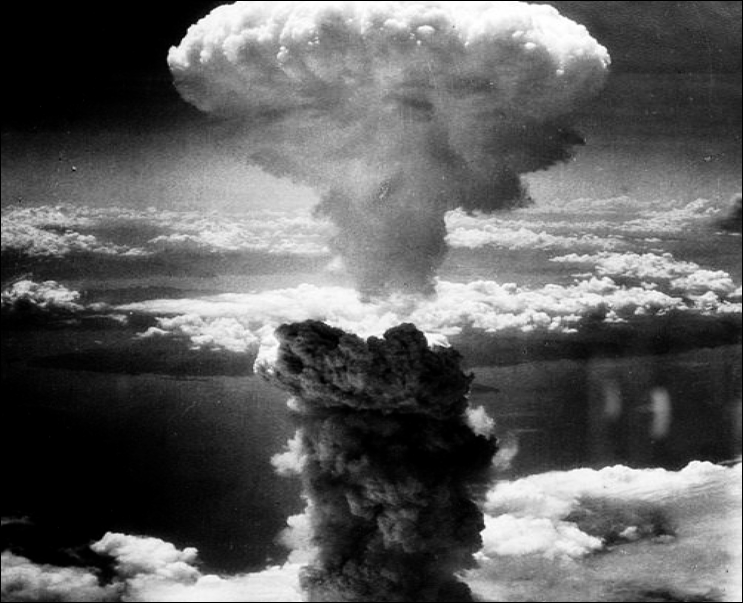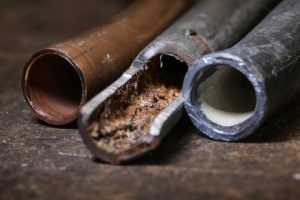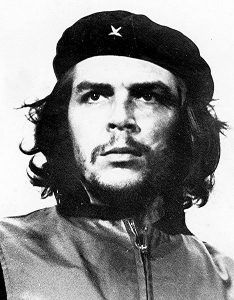Winner of the Spring 2017 StMU History Media Awards for
Best Article in the Category of “World History”
“We knew the world would not be the same. A few people laughed, a few people cried, most people were silent. I remembered the line from the Hindu scripture the Bhagavad Gita. Vishnu is trying to persuade the prince that he should do his duty and to impress him takes on his multiarmed form and says, ‘Now, I am become Death, the destroyer of worlds.’ I suppose we all thought that one way or another.”1
- J. Robert Oppenheimer, The Decision to Drop the Bomb

Throughout the history of human warfare, conflict has pushed humans to innovate–to build ever larger and deadlier weapons, each more lethal than the last. However, it was not until World War II and the invention of the atomic bomb that humanity has been able to kill on such a massive and efficient scale. Case in point, in the final days of World War II, the United States carried out one of the most chilling instances of mass murder in the history of humanity: the bombing of the Japanese cities of Hiroshima and Nagasaki. These attacks ultimately killed an estimated 294,000 people, the majority of whom were noncombatants.2 In comparison, the Japanese attack on Pearl Harbor killed just 2,408 American citizens, although this is largely due to the focused Japanese attack on military targets, namely the Pacific fleet and U.S. airfields.3 To give a more modern frame of comparison, the terrorist attacks against the World Trade Center and Pentagon, considered to be by far the worst terrorist attacks against the United States, claimed the lives of 2,974 American citizens.4
In the spring of 1945, World War II was entering its final stages. The Allies had already achieved victory in Europe with Germany’s surrender on May 7th, but the conflict on the Pacific front was still going strong. In the years leading up to the two World Wars, Japan’s victories against two larger countries–China in the Sino-Japanese War (1894–1895) and Russia in the Russo-Japanese War (1904–1905)–combined with other factors, forged a strong sense of Japanese nationalism, militarism, and cultural superiority. This fervent nationalism, integrated with the Japanese warrior ethic known as bushido, made the prospect of a Japanese surrender unlikely, even as the Allies began to position for an invasion of the Japanese mainland.5

Concurrently, since as early as 1942, President Franklin Delano Roosevelt had been secretly sponsoring and funding The Manhattan Project, the code name used for the $2 billion U.S. effort to develop a nuclear weapon before the Germans. A team of top physicists led by Dr. Julius Robert Oppenheimer were assigned to this project, a task so secret that not even individuals as important as then Vice President Harry S. Truman was aware of it. Shortly after Roosevelt’s untimely death and Truman’s subsequent inauguration to the presidency in April 1945, he was informed that the Manhattan Project was approaching success–that a nuclear weapon would be feasible in just four short months.6
Faced with the prospect of a costly and deadly invasion of Japan, Truman and his advisors were faced with a difficult choice: utilize this new atomic weapon or try to defeat Japan through conventional means. In late July, the United States issued the Postdam Declaration, a statement which gave Japan the choice between unconditional surrender or total annihilation. When this declaration went ignored, President Truman authorized the use of the atomic bomb.7

On the morning of August 6, 1945, Colonel Paul Tibbets piloted the Enola Gay over the city of Hiroshima, where his crew dropped an atomic bomb code-named “Little Boy.” Upwards of 70,000 people died instantly in the blast. Additionally, 48,000 buildings were destroyed and another 22,000 were damaged, leaving only 6,000 buildings untouched. Three days later, on August 9th, a second bomb was dropped onto Nagasaki, killing another 36,000 people. In total, an estimated 295,000 were killed in the blasts or from complications from the resulting nuclear fallout.8
Emperor Hirohito ordered the surrender of Japan on August 10, 1945. On August 15th, radios across Japan broadcasted Hirohito’s words as he read the declaration of surrender to the Japanese people, thus ending World War II. The bombs’ effectiveness in forcing the Japanese to surrender is still subject of popular debate among historians to this day, given that the Russian invasion of Japan-controlled Manchuria occurred at the same time of Nagasaki, both of which likely impacted Japan’s will to continue fighting.9 Even so, while the political and military effects of these blasts may be debated, none can contest their tragedy and devastation.

- Jason Pontin, “Oppenheimer’s Ghost,” MIT Technology Review, October 15, 2007. https://www.technologyreview.com/s/408835/oppenheimers-ghost/. ↵
- Dennis W. Cheek, “Hiroshima and Nagasaki,” in Encyclopedia of Science, Technology, and Ethics, edited by Carl Mitcham, Vol. 2, Detroit: Macmillan Reference USA, 2005. Gale Virtual Reference Library (accessed February 6, 2017), 923. ↵
- Sonia Benson, Daniel E. Brannen, Jr., and Rebecca Valentine, “Pearl Harbor Attack,” in UXL Encyclopedia of U.S. History, Vol. 6, Detroit: UXL, 2009. Gale Virtual Reference Library (accessed February 6, 2017), 1208. ↵
- Stefan M. Brooks, “September 11 Attacks,” in The Encyclopedia of Middle East Wars: The United States in the Persian Gulf, Afghanistan, and Iraq Conflicts, edited by Spencer C. Tucker, Vol. 3, Santa Barbara, CA: ABC-CLIO, 2010. Gale Virtual Reference Library (accessed February 6, 2017), 1096. ↵
- “The United States Drops the Atomic Bomb on Hiroshima and Nagasaki,” in Global Events: Milestone Events Throughout History, edited by Jennifer Stock, Vol. 2, Asia and Oceania, Farmington Hills, MI: Gale, 2014. Gale Virtual Reference Library (accessed February 5, 2017), 361. ↵
- “An Overview of the Atomic Bombings of Hiroshima and Nagasaki,” in The Atomic Bombings of Hiroshima and Nagasaki, edited by Sylvia Engdahl, Perspectives on Modern World History, Detroit: Greenhaven Press, 2011. Gale Virtual Reference Library (accessed February 6, 2017), 13-14. ↵
- “An Overview of the Atomic Bombings of Hiroshima and Nagasaki,” in The Atomic Bombings of Hiroshima and Nagasaki, edited by Sylvia Engdahl, Perspectives on Modern World History, Detroit: Greenhaven Press, 2011. Gale Virtual Reference Library (accessed February 6, 2017), 14-15. ↵
- Dennis W. Cheek, “Hiroshima and Nagasaki,” in Encyclopedia of Science, Technology, and Ethics, edited by Carl Mitcham, Vol. 2, Detroit: Macmillan Reference USA, 2005. Gale Virtual Reference Library (accessed February 6, 2017), 923. ↵
- “The United States Drops the Atomic Bomb on Hiroshima and Nagasaki,” in Global Events: Milestone Events Throughout History, edited by Jennifer Stock, Vol. 2, Asia and Oceania, Farmington Hills, MI: Gale, 2014. Gale Virtual Reference Library (accessed February 5, 2017), 361. ↵



152 comments
Nelson Smithwick
The nuclear bombing of Nagasaki and Hiroshima was a turning point in Human history, the loss of human life was simply tragic. Some argue that a similar amount of lives would’ve been lost had the United States continues its infantry attacks on the Japanese mainland until they surrendered, but regardless, an innocence was lost when the Enola Gay dropped her payload above the Japanese cities.
Luke Trevino
Wow!! I love the story’s of World War Two! There is always something new you can learn when it comes to World War Two. It was truly amazing how you supplied all the casualties of the atomic bomb plus the destruction it caused around the area! The atomic bomb was truly a terrible thing to everyone because it was a stepping stone to new massive destructive weapons. Overall great article!!
Garrette Bradley
I like this article because it gives the exact details on how many people, buildings, etc. died in the two atomic bombs. One thing that I didn’t know was that the Russians captured Manchuria which may of also lead to the surrender of Japan. This shows that no matter how powerful a country or nation is everyone falls one way or another.
Johnanthony Hernandez
Interesting article, the use of the casualties of 9/11 and the attack on Pearl Harbor compared to that of those suffered by the Japanese people of Hiroshima and Nagasaki puts it into perspective. Most do not see the bombing of Hiroshima and Nagasaki as an instance of mass murder or they refuse to except the fact that the United States would do something like that. It’s still hard for me to think that because of the Manhattan Project and the bombing we not only ushered in an age of the constant fear of atomic/nuclear annihilation but one of fear that if the United States created a weapon of such, who else could.
Alexis Soto
Since I was a small child nuclear weapons always fascinated me. Now when I think about nuclear weapons I am reminded of Uncle Ben’s famous quote, “with great power comes great responsibility” because in this case it is true. In present day, multiple nations have nuclear weaponry that could destroy the world at any given moment. In regards to the United States and bombings of Nagasaki and Hiroshima, I cannot say it was the wrong choice or not because I believe the circumstances were different, and I do believe as humans the people at the time could not comprehend the power they created, nor the danger.
Gabriela Medrano
The U.S. lost no time in constructing this choice of weaponry. Your article caused so many mixed emotions, I don’t know if to feel bad for Japan or be glad for the U.S.’s triumph. At least our country provided two options for Japan, not great ones but they were available. With so much killing back and forth i think the bombings were inevitable, the U.S. was already fired up. This topic will always be one of great debate and so controversial. Great read! Well done.
Alejandro Garza
Intersesting to see the bombings of Hirsohima and Nagasaki not only compared to the events of Pearl Harbor which led the United States tp intervene in WW2. But to also compare it to a more recent event; one that we’ve all been alive for, the 9/11 attack on the World Trade Center and the Pentagon. It really puts the loss of human life into perspective and the damage done to the infrastructure of these cities not only through the immediate bombings, but also through the after effects brought about from the radioactive fallout that still affects parts of Japan to this day.
Jennifer Pogue
Great article. I enjoyed your quote at the beginning, it related very well to the rest of the article and kept me reading. However, I would watch the repetition of the variations of “human” in the introduction. These bombings are truly terrifying and tragic. To think of a whole city being destroyed in a matter of seconds is unimaginable for me. You obviously did a lot of research and the article is very well constructed.
Aaron Jaramillo
This is an interesting article. It was filled with great information backed up by credible resources. It was easy to read and had a good flow to it. Also, it was interesting to know that the atomic bomb killed more people than 911 and pearl harbor. I feel the same way about our nuclear weapons today being stronger than the one dropped on Hiroshima and Nagasaki. I’m looking forward to more articles from you. Good job.
Alyssa Valdez
Very informative article. I can tell you did a lot of research for your article, I was never aware of how many lives were taken and how many buildings were destroyed. It is very tragic that so many lives were lost during the war. It is especially unfortunate that many lives that were taken in Hiroshima and Nagasaki were people who were noncombatants.